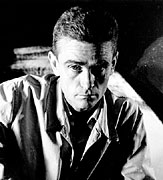
He starts his painting studies at the Raúl Russo and Rafael Oneto ateliers. In 1951 he moves to Paris and studies during three years with André Lothe. In this city he also attends the Ranson Academy, where Gustave Singier and Roger Chaster teach, and he attends the Grande Chaumiére. During this time he also frequents the sculptor Ossip Zadkine´s workshop.
Upon his return to Buenos Aires, in 1956, he begins to work on a series of collages made with pieces of paper, rags, tree bark and other material. In 1958 he exhibits for the first time in a collective show at the New Art Association. In 1959 he takes part in the Informalist Movement. In 1961 he exhibits a collection entitled Paisajes suburbanos (Sub-suburban Landscapes) at the Pizarro Gallery, which includes abstract collages, made with tins and other rusted metals. That year he organizes the Destructive Art exhibition at the Lirolay Gallery. In 1963 he takes part in the Pintura espejismo (Mirage Painting) exhibition.
In 1964 he moves to Boston, where lives until mid 1965. In this city he starts a series of geometric paintings, hung from a corner in a rhomboid position, with harsh borders, which use as the basic form of expression the pure action of the color. He continues with his experimental work in various exhibitions, such as Investigaciones sobre los procesos de la creación (Investigations about the Creative Process), at the Vignes Gallery In 1966, together with Emilio Renart, Víctor Grippo and Enrique Barilari.
With similar intentions he holds exhibits such as El Arbol de los juegos (The games tree), at the El Taller Gallery in 1968, and in 1970 he presents Tres contribuciones para un autorretrato (Three contributions for a self-portrait), at the Fogel Gallery.
He takes part in numerous national and international exhibits and he receives all the recognition that an Argentine artist can aspire to. In 1994 he is awarded the Gran Premio de Honor at the Salón Nacional de Artes Plásticas and the Eco Art award, in honor of the Earth Summit held in Rio de Janeiro. For decades, his atelier located in Buenos Aries has been one of the most attended ones. In 1998, under the title of Kenneth Kemble. La gran ruptura. Obras 1956-1963, an exhibition of his work is presented at the Cronopios room in the Centro Cultural Recoleta, under the curator Marcelo Pacheco.